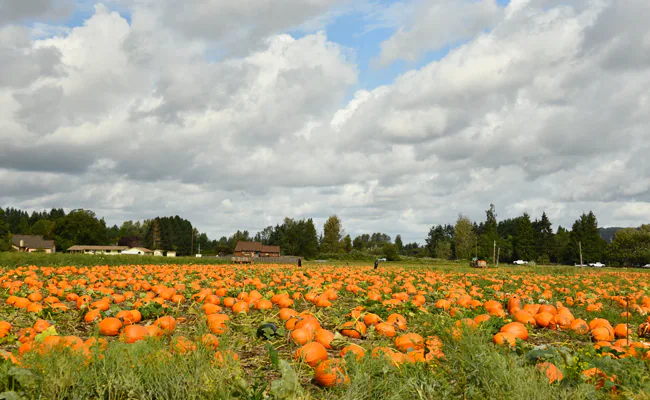
Today, we learned the topic of good pumpkin farming techniques, planting ideas, pumpkin plant care, and pumpkin’s harvesting procedure.
Introduction of Pumpkin
Pumpkin is a famous green, rainy season crop in India. The pumpkin relates to the “Cucurbitaceae” family and is grown extensively during the Kharif season (monsoon) and harvest season throughout India for young and tender fruits. India is the second-largest country producing pumpkins in the world after China. Pumpkin products are consumed in daily cooking and are also used in sweets preparation. In addition, fruit juice, young stems, flowers, and leaves have many medicinal properties.
Commercial Types of Pumpkin in India
- Arka Suryamukhi
- Ambili
- Arka Chandan
- Saras
- Suvarna
- Sooraj
Local Names of Pumpkin in India
Telugu (Gummadi Kaya), Tamil (Poosanikai), Kannada (Kumbalakai), Malayalam (Mathanga), Marathi (Lal bhopla), Hindi (Kaddu), Gujarati (kollaano velo).
Climate needed for Pumpkin planting
Pumpkin farming needs a min temperature of 18℃ at the early stage of its growth. The ideal temperature range is 25 to 28℃ for its cultivation. It adopts a wide range of rainfall situations, and it also tolerates low temperatures.
Most Reliable season for producing Pumpkins
Pumpkin farming can be grown from January to March & September to December. Sowing can also be started after the initial few showers from May to June for the rainfed growth.
Health Benefits of Pumpkin
Some of the health advantages of pumpkin are posted below.
- Pumpkin becomes a Rich Source of Vitamin’ A’ and Potassium.
- Pumpkins have good antioxidant qualities.
- It Boost Eye Vision.
- Pumpkin aid in Sleep Better
- Pumpkin Lower Blood Pressure.
Soil condition and its preparation for Pumpkin Farming
It thrives well in different soils, but sandy loam soil with fresh organic matter best suited. Soil with good waste and a PH range of 6 to 7 is ideal for pumpkin cultivation. The field should be levelled to a fine tilth, well-drained, fertile (can make adding organic compost or FMY (Farm Yard Manure). The selected main area should also have an assured water source. Farmers use many types of machinery for uplifting soil fertility rotavator is one of them, and Rotavator Price is also cost-effective.
Development of the soil for Pumpkin Farming
Dig pits of 60 cm width and 30 to 45 cm depth and keep a 4.5-meter x 2.0 meters spacing. A well rotten FYM (Farmyard Manure) and fertilizers should combined with topsoil in the pit.
How to Plant Pumpkin seeds
4 or 5 seeds are to planted per pit. Dispel any unhealthy or damaged plants after two weeks and retain 3 cuttings per pot.
Manures and Fertilizers of Pumpkin Farming
Farm Yard Manure FYM at 20 to 25 tons/ha as a basal dose along with a half dose of 35 kg of N and a total dose of 25 kg of P2O5 and K2O (25 kg/ha ). The remaining amounts of 35 kg of N should applied in two equal split doses at the time of plantation and full blooming.
Pumpkin Weed Control
Raking the soil at the time of fertilizer application and carrying 2 to 3 hand weeding needed to keep the field weed-free. Earthling up should done through the monsoon season.
Water Demand of Pumpkin Plants
The watering should given in an open field as per the requirement of the plants. During the first stages of pumpkin plant maturity, irrigate at an interval of 3 to 4 days. Washing on alternate days during flowering and fruiting will return high-quality fruits.
Pumpkin Farming Pests and Diseases
Epilachna beetles, fruit flies, and red pumpkin insects are the primary pests in pumpkin plantations. However, they can controlled, as in the case of bitter gourd. Powdery mildew, downy mildew, and mosaic are the primary diseases in pumpkin farming.
Harvesting Of Pumpkins
Pumpkins will be ready for collection when the stems attaching the fruit to the vine begin to fade. Can collect the fruits when they are in deep solid colour, and the surface is hard. Dispel any unhealthy fruit from the vine, use a cutting knife for harvesting with care. Farmers used harvesting machines for productive farming. Along with this, the Harvester Price is also affordable for farmers.
The yield of Pumpkins
The pumpkin yield largely depends on plant administration and the variety of fruit. However, an average result of pumpkin can expected up to 30 tons/ha.
Some Facts of Producing Pumpkins
- It approved to place a piece of wood under growing pumpkin vines to stop root rot disease.
- The number of pumpkins you grow for one plant depends on the type. Regular varieties will give 2 to 4 pumpkins per 1 plant, whereas miniature types will provide more pumpkins per 1 plant.
- The reason for getting pumpkin leaves yellow is a nutrient deficiency or some infestation.
- Always plant the pumpkin roots when the soil warmth is over 19°C and avoid frost situations.
- You can grow a pumpkin indoors, but you have to make suitable conditions for it.
We hope you get this blog informative and for more related blogs, stay connected with us.





